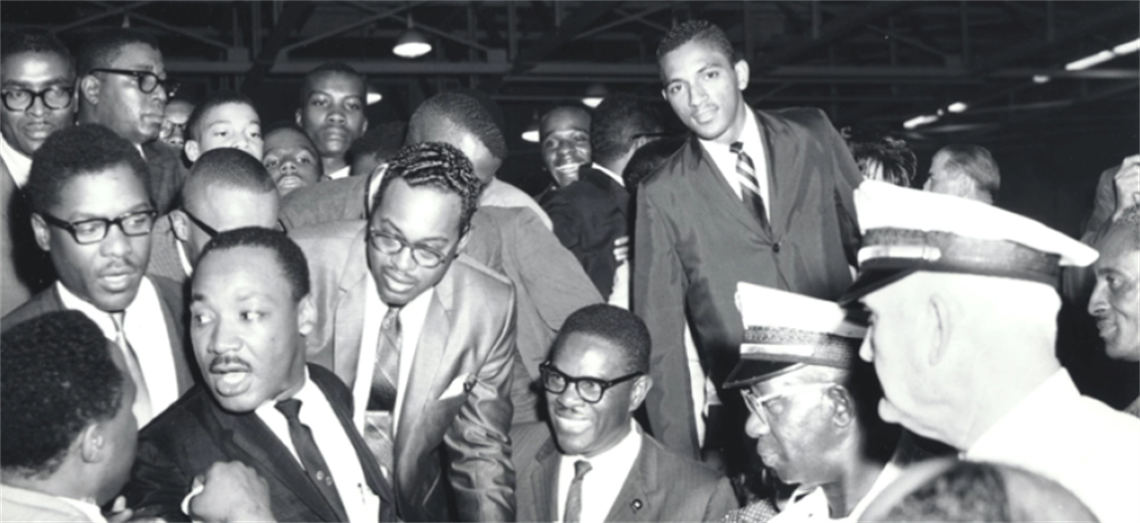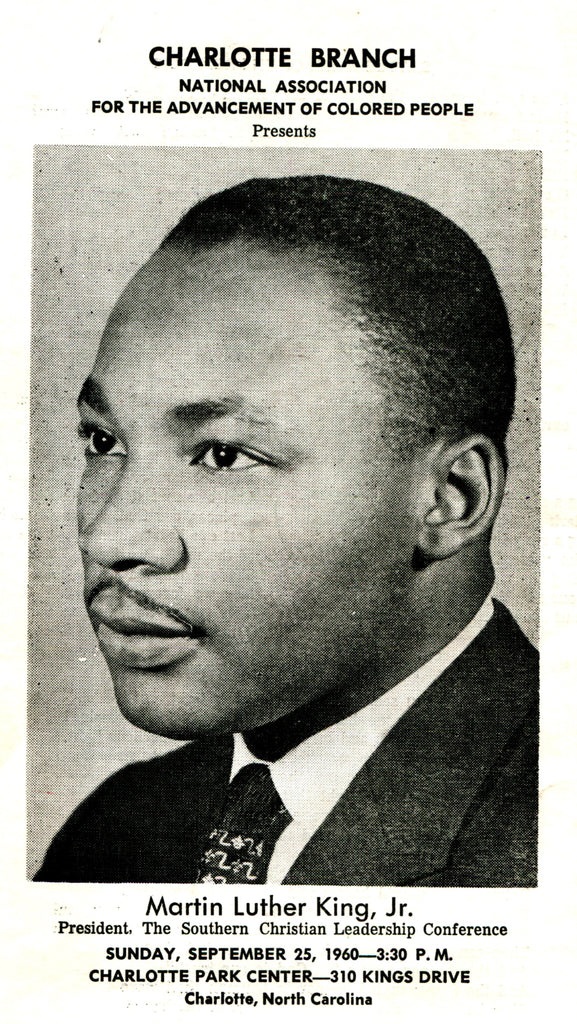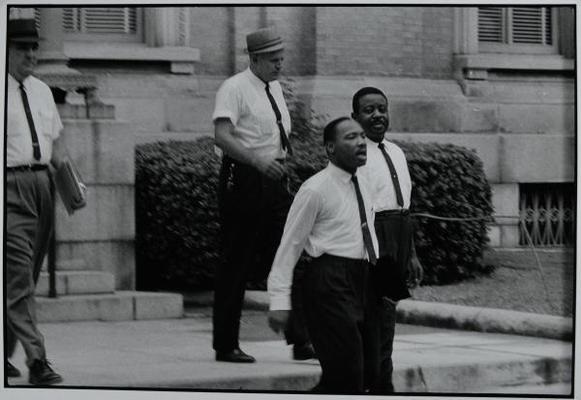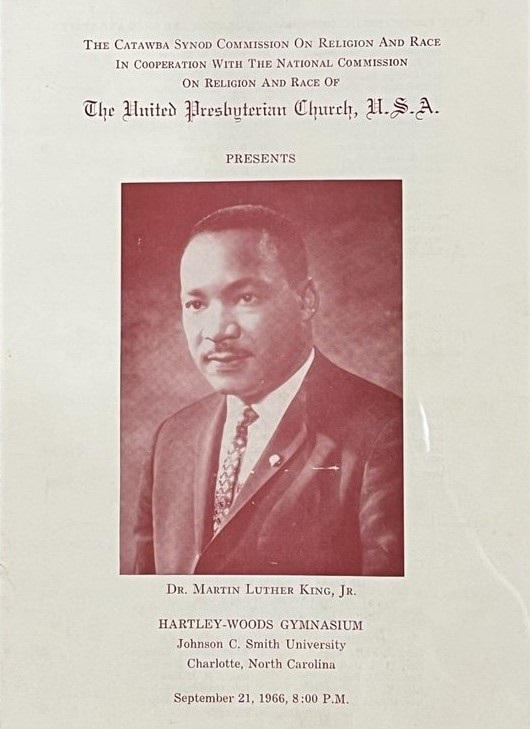MLK in CLT: Martin Luther King, Jr.’s Connections to the Queen City
Published on January 11, 2024

Martin Luther King, Jr. with Reginald Hawkins at Johnson C. Smith University in 1966.
By Kayla Chadwick-Schultz
On April 16, 1963, Dr. Martin Luther King, Jr. wrote one of America’s most important historical documents from the confines of a jail cell in Birmingham, Alabama. Earlier that month, King’s Southern Christian Leadership Conference (SCLC) launched a campaign of nonviolent civil disobedience to protest the city’s extreme racial segregation. According to historian Glenn Eskew, the Birmingham campaign primarily used selective buying (boycotts), peaceful marches, and coordinated sit-ins, yet it was met with violent outrage by the white residents of the city. Birmingham’s Commissioner of Public Safety, Eugene “Bull” Connor, directed high-pressured water hoses and police attack dogs at the nonviolent protestors. When that wasn’t enough, he turned to the courts—obtaining an injunction to bar any forms of racial protest and raise bail bonds for those arrested as a result. SCLC defied the injunction, which they deemed to be unjust and unconstitutional (The Tuscaloosa News), and proceeded with their peaceful protests. King was among the 50 protestors arrested on April 12, 1963.

King in Birmingham overseeing the “Birmingham campaign” prior to his April 12 arrest. (Library of Congress)
So, what does any of this have to do with Charlotte? That’s what this story is supposed to be about, right? Don’t worry, I’ll get there. Just stay with me…
Shortly after King arrived at Birmingham Jail, he was “placed alone in a dark cell, with no mattress, and denied a phone call,” according to sociologist Jonathan Rieder. The conditions for King were unusually harsh and isolating, but he somehow managed to secure a copy of “A Call for Unity.” This open letter, written by eight white clergymen in Birmingham, criticized the methods of the Civil Rights Movement and referred to King as an “outsider.” Rieder suggests that an ally smuggled in a newspaper containing the letter so that King could read it for himself.
In response, King penned the now-famous “Letter from Birmingham Jail.” I’m sure you’ve heard the quote, “Injustice everywhere is a threat to justice everywhere.” Well, that’s from “Letter from Birmingham Jail,” and it is a direct response to King being called an outsider. King also spends a good portion of the document discussing the meaning of justice—from both a legal and moral standpoint. He muses on the state of America, on claims of the Civil Rights Movement’s extremism, and on the need for more allies on the other side of segregation. During the latter, he names exactly four white allies of the movement: Ralph McGill, Lillian Smith, James Dabbs, and Charlotte’s own Harry Golden.
See, I told you I’d get there.

First edition of “Letter from Birmingham Jail” published with an alternate title by American Friends Service Committee. (UNC Charlotte)
Charlotte’s small yet significant shoutout in “Letter from Birmingham Jail” is something that Dawn Schmitz, Associate Dean for Special Collections & University Archives at UNC Charlotte, pointed out to me during my research. I’d requested boxes upon boxes of Harry Golden’s archived materials, knowing that there would be some gems from King inside, but Schmitz wanted to make sure I didn’t miss this. It was on page 11 of the 1963 first edition that King mentioned Harry Golden, who had “written about our struggle in eloquent, prophetic, and understanding terms.” High praise from one of America’s greatest civil rights leaders in one of America’s most important historical documents, and it was directed to a man in Charlotte.
Why? Who was this man? What connection did he have to King? What connection did King have to Charlotte? Who else did he know here? Well, I can’t answer all of that. I won’t even attempt to assume what King was thinking when he put Golden’s name to paper as he sat in a jail cell. What I do know, however, is that Dr. Martin Luther King, Jr. came to Charlotte on several occasions, formed friendships with local civil rights leaders, and delivered speeches that would ultimately transform into iconic moments. This is the story of MLK in CLT.
Early Appearances & New Friendships in Charlotte

King (middle) set to fly out of the newly named Douglas Municipal Airport in 1954. (Charlotte-Mecklenburg Library)
Martin Luther King, Jr.’s rise to fame was gradual at first. He was a Baptist minister, first and foremost, though he often connected with other Black Baptist ministers across the South to speak on social justice and civil rights issues. There is no clear record of when King may have first stepped foot in Charlotte, but we do have a surviving picture (above) of King at Douglas Municipal Airport in 1954. This photo, from the Charlotte-Mecklenburg Library, shows King with the President of the North Carolina National Association for the Advancement of Colored People (NAACP), Kelly Alexander, Sr., to his right.
Alexander was a prominent figure in Charlotte. His father owned and operated the only Black funeral home in the city. He became involved with civil rights activism through the NAACP as early as the 1930s, and he was eager to involve King in local matters right away. However, that gradual fame that King had been building suddenly skyrocketed in 1955 with the Montgomery bus boycott. Everyone knew who he was and wanted his attention.
According to Angel Johnston of the Charlotte Museum of History, Alexander wrote to King in 1958, asking him to return to Charlotte for a speaking engagement. In his letter, he said, “There is still too much apathy and still much work to be done. We know your visit here will be of great advantage.” King had apparently agreed to visit our city that fall, but he was attacked at a book signing event in New York just before his scheduled visit. Instead, King sent his “right-hand man,” Reverend Ralph Abernathy to speak in Charlotte.
It would be another two years before King had the chance to return to the Queen City. The local chapter of the NAACP arranged for the SCLC President to speak at Charlotte Park Center on Sunday, Sept. 25, 1960 (see flyer below).

NAACP flyer for King’s appearance at Charlotte Park Center, now the Grady Cole Center at CPCC, in 1960. (UNC Charlotte)
While there is little question that Alexander was somehow involved with organizing the event to bring King back to Charlotte, Harry Golden’s involvement seems to appear almost suddenly. I looked through some correspondence between King and Golden in his archived material at UNC Charlotte, and I failed to find anything signifying the beginning of their friendship. Somewhere along the way, they met and formed a strong enough bond that King would refer to him in his one of his most important texts.
Perhaps they’d communicated before, when Golden was a reporter for the Charlotte Observer who had started his own monthly publication, the Carolina Israelite—a personal newspaper in which he often advocated for racial integration from the perspective of a New York City transplant living in the South. Or maybe they had connected when Golden took a series of his Carolina Israelite essays and published them in a best-selling collection called Only in America in 1958. That was around the time Golden rose to national fame, according to a 1981 Los Angeles Times article recounting the late author’s life. Or I suppose it is conceivable that they met that very day, on Sept. 25, 1960, when Golden introduced King to the gathered crowd of nearly 2,700 at Charlotte Park Center at 310 Kings Drive. Ultimately, how the two first met doesn’t matter. What matters is that Charlotte resident Harry Golden became a close friend of Martin Luther King, Jr., and the two remained intertwined for the remainder of King’s life.
Following Golden’s introduction, King proceeded to deliver a speech entitled “The Negro and the American Dream.” Angel Johnston quoted some of this speech in the blog article that I referenced earlier. Some of the more notable quotes Johnston shared include: “In a real sense America is essentially a dream – a dream yet unfulfilled. It is a dream of a land where men of all races, colors and creeds will live together as brothers” and “Slavery and segregation have been strange paradoxes in a nation founded on the principles that all men are created equal.” If they sound familiar to you, that’s probably because you’ve heard an iteration of them before…
The speech delivered at Charlotte Park Center was an early version of the famous “I Have a Dream Speech” that King would make three years later at 1963’s March on Washington. Though Charlotte is not the only city that received a test run of this famed speech, it is a notable moment in our connection to the man we honor every year.
King, in High Demand, Still Makes Time for Charlotte

King and Abernathy being escorted from the courthouse to the jail in Albany, Georgia in 1962. (Danny Lyon/Library of Congress)
On July 10, 1962, Harry Golden received a telegram from Wyatt T. Walker, Executive Assistant to Dr. King. The telegram informed Golden that King and Rev. Ralph Abernathy “elected to serve a 45-day jail sentence at Albany, Georgia for peacefully protesting segregation last December.” This two-part telegram can be found in Harry Golden’s collection of archived materials at UNC Charlotte. The remainder of the message explains that King and Abernathy “chose to defer bail or payment of fine out of concern for [the] fate of 700 others similarly situated” and asks Golden to “join us in protesting these unjust jail sentences.”
Similar to what would happen a year later in Birmingham, the decision to conduct peaceful protests in Albany was made strategically. It was a heavily segregated area that needed change. King and Abernathy felt called to it, and they launched what would become The Albany Movement in 1961. Outside of King’s arrest, this movement was a notable for being a first-time collaboration between SCLC and the Student Nonviolent Coordinating Committee (SNCC), which had criticized King and his unwillingness to get his hands dirty, so to speak, in the past. This is according to some historians, such as Peter J. Ling, but I’m not going to get into the nuances of SCLC vs SNCC here. That’s not the point of this article. This article is about Charlotte, so… Why am I talking about Albany again?

The second telegram Golden received regarding King’s arrest in Albany. (UNC Charlotte)
Right. As I said, King’s executive assistant sent a telegram to Harry Golden in Charlotte (above). He informed Golden of the decision to serve the jail sentence and asked for assistance in protesting it. 19 days later, Golden received another telegram from Walker: “Martin Luther King Jr., Ralph D. Abernathy, and more than 200 others are now jailed because they have peacefully protested segregation in Albany, Georgia. We insist that First Amendment privileges must be respected everywhere in this nation.” The telegram goes on to describe the conditions of the jail as “inhumane and insufferable.”
Sound familiar at all? King’s arrest and subsequent jailing in Albany was somewhat of a precursor for Birmingham the following year. Only, instead of publishing one of America’s greatest historical documents, he sent telegrams to friends through his executive assistant and asked them to help drum up the necessary public outrage. Golden did his best work in front of a typewriter rather than in the streets, so that’s how he helped. He wrote.
Another Charlottean supposedly went a step further, discreetly bailing King out of jail. This was friend and fellow preacher Billy Graham. Perhaps, Charlotte had more of a connection to Albany, Georgia than we’d previously known. Either way, King got out of jail in Albany only to find himself back in jail in Birmingham—where this article began.

King speaks to Charlotte’s Black high school students on May 30, 1963. (Charlotte-Mecklenburg Library)
Truthfully, from the 1960 presidential election all the way up until his assassination in 1968, King never took his foot off the gas. He went from one campaign to the other, still somehow finding the time to visit various cities and towns in the South—including Charlotte. In May of 1963, one month after Birmingham, King spoke at a convocation of Charlotte’s Black high schools (above). A few months later, he was delivering the “I Have a Dream” speech in Washington, D.C.
King became the youngest winner of the Nobel Peace Prize in Oct. 1964. A year later, King wrote a letter to Golden to notify him that he would be using the entire $25,000 Nobel Peace Prize proceeds to create the American Foundation on Nonviolence and to ask Golden to be on its inaugural Board of Directors. He quickly accepted the offer in a follow up letter, which again can be found in his archived collection at UNC Charlotte.
Between 1964 and King’s next visit to Charlotte in 1966, SCLC launched campaigns across the country—most notably in Selma, Alabama. The Civil Rights Movement had gained more notoriety than ever before during the march from Selma to Montgomery. This notoriety had more to do with violent police response to the peaceful march than anything King or his comrades did. A day called “Bloody Sunday” became infamous, as protestors were brutalized on Edmund Pettus Bridge by Alabama state troopers.
The events at Selma were a major turning point for the movement. Questions arose about whether nonviolence would ultimately achieve anything. Was any of this even working? King took to the road to address some of these concerns. He stopped in Charlotte on Sept. 21, 1966, when he spoke to “an audience of almost 5,000 people inside and outside Johnson C. Smith University” (“King Calls for Use of ‘Striped Power,’” Charlotte Observer, Sept. 22, 1966).

Flyer for King’s 1966 speech at Johnson C. Smith University. (UNC Charlotte)
Just as more people began supporting the movement following the events of Selma, more people also started to vehemently oppose it. The police force in Charlotte took no chances during King’s visit. Their primary concern was ensuring that King got in and out of their city unharmed, so they stationed uniformed officers across Charlotte and provided a policemen escort every time King traveled from one destination to another (“King’s Visit Keeps Police Force Busy,” Charlotte Observer, Sept. 22, 1966).
The speech itself covered a lot of important topics, including how racial integration and poverty were “the two greatest problems facing America” in 1966. He made a note of how active the Ku Klux Klan was in North Carolina, which can be heard in a rare recorded clip of the speech. However, according to the Charlotte Observer, the greatest takeaway from the speech King delivered at JCSU was his continued commitment to nonviolence. King said that nonviolence “ultimately exposes our opponent, weakens his morale, and works on his conscience.” Nowhere was that more evident than on Edmund Pettus Bridge in Alabama.
King ended the speech with, “Black and white together, we shall overcome,” to raucous applause. This would be the last time King would make any kind of public appearance in Charlotte. Although, it wasn’t supposed to be…
One Fateful Telegram Delivered to Charlotte

The telegram sent to Reginald Hawkins on April 2, 1968, two days prior to King’s assassination. (UNC Charlotte)
Before Reginald Hawkins became the first African American to run for Governor of North Carolina, he was a graduate of Johnson C. Smith University and active member of the Charlotte chapter of the NAACP. He often worked alongside Kelly Alexander, though their approaches sometimes differed. Actually, that’s not true. Though their goals aligned, their methods nearly always differed—leading the two Charlotteans to often have disagreements. According to the North Carolina History Project, Hawkins left the NAACP in 1958 to create the Mecklenburg Organization for Political Affairs (MOPA) to mobilize the Black community without the NAACP, which had gained a reputation for being “communist”—a politically toxic label in the 1950s.
Similar to Golden, it’s unclear how and when Hawkins became friends with Martin Luther King, Jr., but the two knew each other well. In fact, Hawkins helped organize the 1966 speech at his alma mater. He was also responsible for organizing a speech that was set to occur in April of 1968. It was to be King’s return to Charlotte, and it was likely meant to support Hawkins’ first attempt to receive the Democratic nomination for N.C. Governor while also advocating for the continued desegregation of the city.
On Apr. 2, 1968, Hawkins received a telegram from Dorothy F. Cotton, an educational director within SCLC. The telegram (pictured above) stated the following: “We are sorry to have to inform you at this last minute of the postponement of Dr. King’s scheduled tour of your area. You are probably aware of the situation in Memphis. Our steering committee felt that because of the crucial issues there, Dr. King should spend several days there immediately. We are grateful for your efforts and contributions, and we will be in touch with you in the next two weeks regarding the new tour schedule. We do look forward to being with you then.”
Two days later, Martin Luther King, Jr. was assassinated in Memphis, Tennessee. He was supposed to be in Charlotte, North Carolina.
This telegram is easily Charlotte’s most famous connection to King. It sits in Box 1, Folder 21 of the Reginald Hawkins papers in UNC Charlotte’s archives, and let me tell you… There is something eerily powerful about it when you hold it in your hands. It’s almost like a voice shouting in your head to warn him, to convince him not to stay in Memphis, to do something, anything, that might change history. You can’t, of course, but when you’re holding it, it feels like you should be able to. It’s hard to accept the fact that the small rectangle in your hand sealed the fate of one of America’s most prominent figures. There’s a certain weight that comes with holding the 0.01lb document. Then again, I have a master’s in history, so maybe it’s just me who gets all sentimental about this kind of thing.
Either way, whether you love history enough to read this entire article or not, Charlotte does have this significant (albeit morbid) connection to Martin Luther King, Jr. Our city will always be the place he was supposed to go when he was killed. However, his legacy in Charlotte is so much bigger than that. He built it in every speech, whether at local Black high schools or packed university gymnasiums. He built it in every friend, from acclaimed authors to Charlotte-based activists. King built a legacy far greater than a single telegram, no matter how significant that telegram may be. So, on this day and every other Martin Luther King, Jr. Day, we honor the legacy he built in Charlotte and beyond. We are proud to call Dr. King one of our city’s greatest allies and friends.
Happy Martin Luther King, Jr. Day!